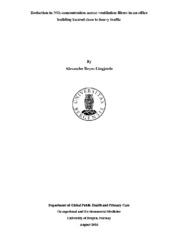Reduction in NO2-concentration across ventilation filters in an office building located close to heavy traffic
Master thesis
Permanent lenke
https://hdl.handle.net/1956/15498Utgivelsesdato
2016-09-21Metadata
Vis full innførselSamlinger
Sammendrag
In Scandinavia, people live in climatic conditions that makes it favorable to stay indoors at wintertime. Norway has a relatively small population, even so Bergen and Oslo reaches annual average nitrogen dioxide concentrations equal to or above the levels in large European cities. Newspapers in Bergen recommend the population to stay indoors in urban areas that are highly polluted. Bergen municipality takes measurements of the outdoor pollution continuously, but more knowledge is needed on the propagation of the pollution from the outdoor and to the indoor environment. Danmarksplass intersection is one of the most trafficked and polluted areas in Bergen, Norway. Surrounding terrain and meteorological conditions during wintertime results in accumulation of local air pollution, locally known as the lid. Bergen municipality is then often obligated to implement mitigating actions. Particles and nitrogen oxides from traffic emissions has been recognized as a major contribution source to local air pollution. Nitrogen oxides are formed during combustion. Among the different nitrogen oxide components mainly nitrogen dioxide (NO2) is associated with negative health effects. This study was set up to compare the effectiveness at reducing NO2-concentration from outdoor to indoor environment at an office building by a combination filter (active coal + particle) and a regular particle filter. In addition, NO2 propagation from the location of the municipality instrument and mentioned office building was examined. Two Teledyne API 200E direct reading instruments were used for measuring NO2. The instruments were deployed outdoors and indoors at an office building. The measurements took place in January to March 2014, when the highest concentration of air pollution was expected. A total of 625 1-hour mean values of NO2 were included in the study. The results show that the NO2-concentrations are approximately 30% lower at the location of the office building than the municipality deployed instrument. The results show that when a regular particle filter was used there was no reduction of the NO2-concentration. However, the combination- filter reduced the average indoor NO2- concentrations by approximately 70% compared to outdoor level. Thus, when local historical data show that the outdoor NO2-concentration can reach levels close to or above the Norwegian Institute of Public Health recommendations, the present study indicates that it is advisable to install a combination filter.
